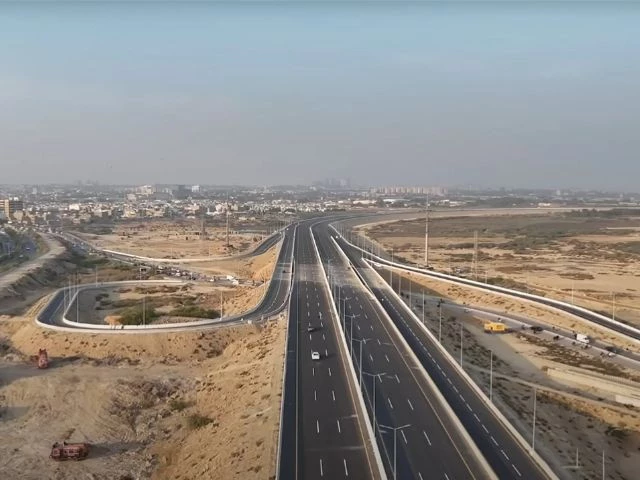In Karachi, urban development is often treated like a race to modernize, rarely thoughtful. Expressways, flyovers, and concrete corridors are celebrated as progress. But when we look closely at two of the city’s most prominent infrastructure projects, the Lyari Expressway and the Malir Expressway (Shahra-e-Bhutto) we discover a complex story that raises uncomfortable questions about displacement, ecological damage, and the actual beneficiaries of these megaprojects.
The Lyari Expressway, launched in 2002 under late General Pervez Musharraf, was projected as a strategic bypass to ease port traffic and reduce congestion in the city. It was a state driven initiative, executed by the Frontier Works Organization (FWO) under the supervision of the National Highway Authority. Originally planned for completion in 30 months, the project dragged for over 15 years. Costs ballooned by more than 150%, and human misery was immense as around 24,000 families were uprooted and relocated to the city’s peripheries.
While compensation and basic utilities eventually followed, the damage to livelihoods was irreversible. Communities were settled in far flung areas of Karachi, plots were allocated in Hawksbay, Taiser Town, Baldia Town, informal economies were disrupted, and access to education and healthcare severely compromised. Yet, despite its painful incubation, the Lyari Expressway now functions as a critical artery for port logistics. It stands flawed but functional as a credible piece of infrastructure that serves a strategic public purpose.
Read: Malir expressway threatens farmland, ecosystem, local heritage
The Malir Expressway, however, tells a different story. Planned as a 39 kilometre corridor along the Malir River floodplain, it cuts through fertile farmland, indigenous settlements, and one of Karachi’s last remaining ecological buffers. Unlike the Lyari Expressway, which followed a degraded riverbed, the Malir Expressway encroaches on land that sustains livelihoods and shields the city from floods. The project was approved by the Sindh government under Chief Minister Murad Ali Shah and was pushed through the Public Private Partnership (PPP) Policy Board and cleared by the Sindh Environmental Protection Agency (SEPA), despite objections from environmental experts and local communities. The expressway is being executed by Malir Expressway Limited, a special purpose vehicle backed by private sponsors, including JN & Co., Niaz Muhammad Khan & Brothers, and Habib Construction Services. Financing comes from major banks such as Habib Bank Limited, Bank Alfalah, United Bank, Meezan Bank, and Pak-Kuwait Investment Company. The Government of Sindh also holds equity in the venture.
Initially, the Asian Development Bank (ADB) was considered a potential sponsor, but it withdrew support over concerns related to environmental compliance. The question is, who gains from this project? While the Lyari Expressway was aimed at improving port and industrial area connectivity, the Malir Expressway is widely seen as a road to real estate expansion. Elite housing developers on Karachi’s outskirts are set to benefit, while farmers’ communities are displaced, green spaces wiped out and flood risks heightened.
The ecological implications are alarming. By playing with natural drainage patterns, destroying farmland, and destroying floodplains, the Malir Expressway risks turning ecological guardrails into urban liabilities. In a city already vulnerable to climate extremes due to reckless planning, Karachi has started witnessing devastating urban flooding in recent years, and projects like Malir Expressway (Shahra-e-Bhutto) only increase that risk.
Read More: Lyari Expressway marred by lack of upkeep
Pakistan’s development model continues to equate concrete with progress. We talk a lot about climate and community, but when it comes to city planning, these ideas rarely make it past the drawing board. Karachi has the technical skills but What it lacks is a political system willing to put people and the planet before profit. Both expressways reflect the politics of their time. The Lyari Expressway was a showpiece of dictatorship, executed with force but focused around industrial and logistical needs. The Malir Expressway, though a civilian PPP initiative, is no less political. It feels like a handful of builders, bankers and officials are driving this project but for their own gain - who cares about bloody civilians?
The real difference is credibility. The Lyari Expressway, despite its flaws, gave the city a transport corridor that serves a clear purpose. The Malir Expressway, on the other hand, was controversial from day one because it’s built on shaky ground. It is ecologically damaging, socially divisive, and financially tilted toward those already in power. It doesn’t miss the mark on timelines but it misses the goalpost on public interest.
Karachi does need infrastructure that serves the public good. Public equity and sustainability must be central to our planning ethos or our expressways will remain monuments of political eras. We need roads that may ease traffic for many but don’t flood the lives of any.
The writer is a former MPA, an education and child rights activist with 28 years of experience as a tech professional.



COMMENTS (4)
Comments are moderated and generally will be posted if they are on-topic and not abusive.
For more information, please see our Comments FAQ